Key Information
Tour Duration: 11 day(s)
Group Size: 1 – 14 people
Destination: Uzbekistan
Location: West Tien-Shan Mountains
Specialty Categories: Mountain Trekking/Mountain Climbing
Grade: Moderate to fairly challenging
Season: June – October
International Airfare Included: No
Local Transportation Included: Yes
Foodstuffs (survival ration) Included: Yes
Personal Travel Insurance Included: No
Personal Equipment Included: No
Tour Customizable: Yes
Mountain Guides
Service Included: Yes
Porters Availability: Yes
Cook Availability: Yes
Guide/Climbers Ratio: beginners – 1:5; advanced – 1:7 (maximum
limit)
Download a Map: 2736×1920 1,25 МБ (1 314 816 байт)
Trek Price Per Person –
Contact information
https://t.me/ClimberCA – telegram
WhatsApp / Viber +7966 065-53-44
e-mail – your@climberca.com
Day 1. Мар.
We start from the Railroad station in Tashkent at around 8 o’clock in the morning. In about two hours we arrive by train to the Hojikent station. It is a first point of the trek, which is located at a height of 880 m. We start climbing southward following the Bulaksu River back to its sources. Halfway rest, lunch under the shady trees near to one of the Bulaksy River’s sources. After lunch we continue climbing toward the Bulaksu Pass 1900 m (+1020 m). You get a splendid view of the Chimgan area from the Bulaksu Pass. There is water welling up from the earth near to this pass. This is a place of the first camp.

This is a starting point of the trek, which is located at a height of 880 m. We start climbing southward following the Bulaksu River back to its sources and then continue climbing toward the Bulaksu Pass 1900 m |

View back to the ravine of the Bulaksu River. At a distance – the Karjantau Ridge and the Chirchik River. |
Note: For the first two days you will have minimum of package, all your spare packages will meet you at the end of second day in Camp 2.

You get a splendid view of the Chimgan area from the Bulaksu Pass. |
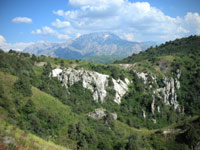
View to the the Akshurang Pass (1735 m) from the place of first camping. |
Day 2. Map.
Today we make our way towards the Greater Chimgan Mountain. We pass Akshurang then climb to the Mingtukum Mountain (1960
m), walk down the ridge to the Archaly Pass (1595 m) and then hike a bit eastward to Kiziljar. This is a place of our camp 2. Towards evening we climb to the Kiziljar Mountain (1900 m) in order to take pictures of the Greater Chimgan Mountain from arguably the most optimal earth-based view point.

The Kiziljar (Red Steep) Mountain (1900 m) and the Greater Chimgan Mountain (3309 m) – the highest point of this trek, soon you will be there. |

View of the Greater Chimgan Mountain from arguably the most optimal earth-based view point. |
Day 3. Map.
Repackaging in order to take outfit and foodstuff for the next 6 days. Use of service of the mountain porters is recommended. Our target for this day is the Beldersay river, which springs from highland between West Ridge and Southwest Ridge of the Greater Chimgan Mountain. During first half of this day we climb to West Ridge (Northwestern Spur), pass the Tahtajaylau Saddle (2190 m) and then descend to the Marble Rivulet. Halfway rest, lunch, excursion downstream of the rivulet. After rest we climb to Western Spur of West Ridge towards the Urta-Kumbel Pass (1850 m). From the pass we descend to the Beldersay River, where we set up our third camp.

View to the Urta-Kumbel Pass (1850 m), the Chet-Kumbel Pass (1880 m) and the Kumbel Mountain (2306 m) from the Tahtajaylau Saddle (2190 m).

On the riversides of the Marble Rivulet th ere are plenty of petrified seashells. |

Hip bath of pure marble downstream of the Marble Rivulet.

View to the ravines of the Shalkuma / Beldersay
revers and SW Ridge of the Greater Chimgan Mountain from the place near to the third camp. |
Day 4. Map.
Today we go south-westward via the Chet-Kumbel Pass (1880 m) to the place of confluence of the Bercota River with the Nurekota River near to the Nurekota village.

View from the Chet-Kumbel pass to the Greater Chimgan Mountain and its SW Ridge.

View from the Chet-Kumbel pass to the Nurekota Valley, Mirzabay Ridge.
At a distance – Imetey (2731 m) and Akkul (2886 m) mountains. |

View of one of typical mountain rivers, locally called “says”. |

Pure and cool waters of a say (mountain river). |

This is how a typical shepherd’s holding in Tien Shan looks like. |
Day 5. Map. Map.
Climb up the Akkul Ridge – reach the Imetey Mountain (2731 m) – roundabout the Akkul Mountain (2886 m) – set up a camp before one reaches the Aksakota Pass.

Mountain Ridge in West Tien Shan’s highland. |

Nearly mountain peak. |

Roundabout the mountain peak. |
Day 6. Map.
Climb up the Aksakota Pass (2450 m) – move to the Minjilki Ridge – hike northeast by the ridge via the Karangur Mountain (2942 m) and the 2852 m Mountain to the Pulathan Pass (2590 m) – set up a camp near head waters of the Karaarcha River.

Mountain Ridge in West Tien Shan’s highlands. |
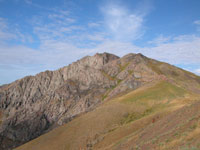
Passing by mountain peak. |

Mountain river head. |
Day 7. Map.
Excursion to the Pulathan Plateau – return to the camp. Pulathan looks as if it has been sliced off the mountain range (highest point of the Pulathan Plateau is 2823 m). Over time, many caves have been formed by the water which accumulates there. One can climb Pulathan only from the Pulathan Pass; it is inaccessible from the other sides.

Panoramic view to the Pulathan Plateau from northwest.
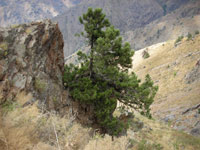   Natural Mountain environment of the West Tien Shan’s
highlands.
Day 8. Map.
Return to the Mingjilki Ridge. Transfer lengthwise the Mingjilki Ridge: the Mingjilki Mountain (2842 m), the Jar Mountain (2936 m), the Tahta Pass (2620 m). Set up a camp near the place, called Lazurnie Lujayki. In the environs of the Mingjilki Pass it is possible to explore petroglyphs picturing. The age of these rock paintings amounts many thousands years. In the area one can frequently encounter the ruins of ancient settlements, burial mounds, and, of course, petroglyphs on the rocks.
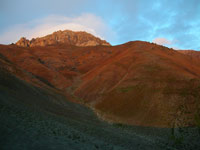
View to the Greater Chimgan Mountain from a place near to the camp. |

View back to the Mingjilki Ridge from a place near to the camp. |
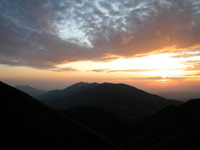
View back to the Mingjilki Ridge at sunset. |
Day 9. Map.
Change of the porters, other porters, full of strength, bring fresh foodstuffs to this place for the next three and a half days. Repackaging and then ascent to the Greater Chimgan Peak (3309 m). Descent to the Komsomolec Pass (2700 m) of Central Ridge. Set up a camp.

Climb to the Greater Chimgan Mountain from the Tahta Pass. |

View to south-eastward from southern slope of the Greater Chimgan Mountain. The Pulathan Plateau. |

On top of the Greater Chimgan Mountain (3309 m), gazing at the splendid view. |
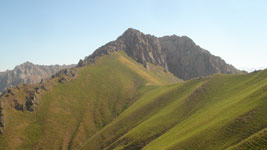
View to the Komsomolec Pass – 2700 m. |

View from the Komsomolec Pass to the Pulathan
Plateau. |
Day 10. Map.
Descent to Aukaska tract. Rivers Semizsay, Tectoshsu, Mazarsay. Crossing NE Ridge of the Greater Chimgan Mountain, descent to Kuyluksay river. Set up a camp near to the place, called Vodoprovod. Towards evening – excursion to the snowfield and rocks upriver Kuyluksay.

Semizsay |

Tectoshsu |

Mazarsay |

Aukashka |

Mazarsay River, Yangikurgan village, Charvak water reservoir, Burchmulla village on the opposite side of the Charvak water reservoir. |

Kuiluksay River |
Day 11. Map.
Hike to the Kuchkinakuksay River, passing picturesque gorge of the Gulikamsay river, deccent to Yangikurgan village. Hike to the shore of the Charvak vater reservoir. Set up a camp.

Kichkinakuksay
Day 12.
Rest ashore the Charvak Water Reservoir. Departure for Tashkent at about noon.

View to the Charvak Water Reservoir from the standpoint near to the Ishakkupruksay River. |

View to the Charvak Water Reservoir from the standpoint near to the Kulabsay River. |

Diving to deep waters of the Charvak Water
Reservoir. |

View to south-eastward from the place of last camp. From right to left: the Aukashka spur, completed with the Patandozbashi Mountain 1877 m; the Aukashka Mountain 3099 m; the Chatkal River; the Imanhan Mountain (2363 m); the Paltau Mountain (2023 m).
|












































